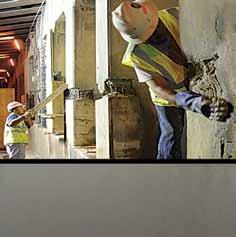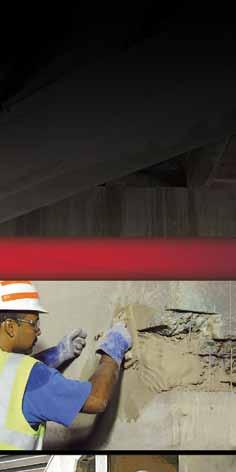
12 minute read
unintentional Corrosion by structural design
– Othello, Act 1, Scene 2, by William Shakespeare, circa 1603
Corrosion has been a problem since the beginning of the Iron Age, circa 1200 BC. Before the Industrial Revolution, corrosion was recognized and respected in hand-produced objects, such as weapons. After the advent of machinery that was used to fabricate metal alloys for structural framing members and components exposed to the elements, corrosion found new targets. The metal alloys include but are not limited to wrought iron, cast iron, hot-rolled steel, and stainless steel. Corrosion of metals is caused by either a chemical reaction or electrification, in which the base metal is changed and eaten away. An example of chemical interaction is the oxidation of iron in the presence of water by an electrolytic process to form iron oxide (i.e., rust). An example of electrification is a rapid-transit system, in which stray direct currents (DC) can corrode rails and nearby metallic infrastructure components, such as buried pipelines and cables. Corrosion has eight unique forms, which are more or less interrelated. These include the following in no particular order: (1) uniform or general attack, (2) galvanic or two-metal corrosion, (3) crevice corrosion, (4) pitting, (5) intergranular corrosion, (6) selected leaching or parting, (7) erosion corrosion, and (8) stress corrosion. Today, rusted vehicles no longer litter the landscape. From this, casual observers and perhaps some structural engineers may not realize that these vehicles have been recycled, and that technological advancements have ameliorated nearly all rust in modern-day vehicles. Some may also conclude that rust and various types of corrosion are no longer of concern, because they see essentially no rust in the landscapes; but rust and corrosion in general have by no means disappeared. Corrosion, although touted as “a natural but controllable process,” is an ultra-expensive nemesis of steel and reinforced concrete structures. In 1998, direct corrosion costs were approximately $276 billion or 3.1% of the GDP. The costs included but were not limited to utilities, drinking water and sewer systems, gas distribution, waterways and ports, and highway bridges. A recent publication stated, “In the 15 years that have passed since the [NACE] study was released, inflation has driven both the direct and indirect costs of corrosion over $500 billion annually, totaling over $1 trillion in 2013 … At 6.2% of GDP, corrosion is one of the largest single expenses in the US economy yet it rarely receives the attention it requires. Corrosion costs money and lives, resulting in dangerous failures and increased charges for everything from utilities to transportation and more.” This article presents two examples of corrosion that were unintentional byproducts of structural designs. The first example, electric power transmission towers constructed from weathering steel, describes uniform or general attack corrosion. The second example, stress corrosion with hydrogen embrittlement, entails the design of a cofferdam and its waler bolts.
Lessons Learned
problems and solutions encountered by practicing structural engineers
Example 1
Aesthetics versus Durability: Premature Use of Weathering Steel The stage for the first example – a corrosion problem, specifically the formation of rust within structural joints – was set circa 1965-1966, when structural engineers began selecting weathering steel for bolted structural members, typically angles, in electric power transmisUnintentional Corrosion by Structural Designsion towers. Weathering steel is a highstrength, low-alloy steel that forms a tightlyadhering “patina” during its initial exposure to By Julie Mark Cohen, Ph.D., P.E., moisture and oxygen. The patina, an oxide film of SECB corrosion by-products, formed early on between bolted plate elements of the angles and continued to grow as “pack-out” rust. This rust, which decreased the cross-sectional area of the bolted members, forced bolted plate elements apart. On some occasions, bolts have fractured from excessive axial tensile stress. When the transmission towers were designed, no guidelines existed for bolting weathering steel Julie Mark Cohen, Ph.D., P.E., structural members that were exposed to the SECB (jmcohen@jmcohenpe.com), elements. After corrosion was observed, design is a consulting structural and forensic guidelines were developed and published. They engineer and published fiction provided information for bolt spacing, edge writer in Latham, New York. This distance, and clamping forces to minimize article constitutes a small part of the possibility of formation of “pack-out” rust her research, entitled Structural between bolted plate elements, such as angles. Engineers: Constraints on Design Transmission towers that were adversely affected Decisions and Subsequent, Costly still exist and/or are being replaced in at least Failures 1950-2014. Virginia and New York.
Example 2
Caveat Emptor: Misuse of ASTM A722 A second example is the result of U.S. manufacturers misusing an ASTM standard. This problem has gone unrecognized by structural engineers, even though failures have occurred. Specifics of nearly all of these failures are not in the public domain. This example is presented by using a
The online version of this article contains several detailed references. Please visit www.STRUCTUREmag.org.
fictitious scenario of the design of a marine structure, specifically a cofferdam. However, the impetus for misuse is factual, and the risk of subsequent failures is real. Design of a Fictitious Cofferdam Elliot Buyer is a 40-year-old structural engineer who earned a bachelor’s degree in civil engineering and a one-year project master’s degree, both with honors, and easily passed the FE, PE, and SE exams. He works in the century-old, well-respected firm, Clev-R Structural Engineers. In February 2014, Elliot procured a project from an international corporation to replace a 71-year-old, 650-foot-long cofferdam in the local ocean harbor. He felt comfortable working single-handedly, because he had designed dozens of large, complicated retaining walls in highly saturated soils, none of which had ever shown signs of distress. Recalling that Clev-R worked on another cofferdam project in the early 1990s, Elliot searched his office’s library. He ignored an unlabeled manila folder with a plastic-laminated article entitled “Atoms Villain in Culvert Collapse” that discussed the failure of A490 bolts. The failure was attributed to hydrogen embrittlement, “a phenomenon occasionally experienced in metallurgy but never before known to have occurred in highway culvert construction.” The article stated that the following three factors must be simultaneously present for hydrogen embrittlement to occur: stress, susceptibility, and a wet environment. Next to the manila folder, Elliot found a sheet pile design manual published by United States Steel. Near the manual, he discovered a binder, labeled Supplements to the Sheet Pile Design Manual, that was initialed by RC III. The binder included examples of waler designs with top and bottom channels stitched together, soil gravity loads on walers, and approximate analyses for continuous walers. He also discovered calculations for a smaller cofferdam’s waler bolts and tie-back rods using ASTM A325 material. In addition, he observed that the waler bolts were designed for axial tension plus bending, “just in case the walers rotate downward.” Elliot quickly realized that he would need high-strength steel for the waler bolts and tie-back rods. He searched the internet and learned that U.S. manufacturers were selling ASTM A722 threaded rods with the option of hot-dip galvanizing. He prepared a thorough, well-documented calculation package and requested an in-house peer review from a more seasoned colleague, Denis L’Accord. Denis spent two days reviewing Elliot’s work, but had no comments, not even minor ones. The construction of the new cofferdam commenced in mid-summer and was completed in late fall 2014. A barely measurable out-ofplumbness was introduced into the sheet piles, but Elliot was confident that it was within acceptable levels and that the conservative waler bolt design was more than adequate. Cofferdam Failure At dawn on New Year’s Day, January 2015, the cofferdam failed: the sheet piles tilted toward the ocean, and the soil sank behind them. By 10 a.m., Elliot, Denis, and Roger Clevstone III (RC III), grandson of the founding principal, were poring over Elliot’s calculations, construction documents, reports by an independent inspector, and photographs taken during construction. The manufacturers’ catalogs sat at the bottom of a stack at the end of the conference room table. The men were mystified. Preparation of Deposition Questions The client, a private corporation, hired Quinn Santiago, Esq., an attorney who was wellknown for winning lawsuits on failing to meet the standard of care. In his thirty years of litigation, he had seen dozens of highlytrained professionals who did not realize that they lacked the knowledge to make informed design decisions. In turn, Quinn hired Abigail Sorrel, a consulting structural and forensic engineer, who was well-respected for what others called a “multi-disciplinary” approach to problemsolving. She fought against this designation, contending that any knowledge needed to solve a particular discipline’s problem is requisite to that discipline. The reports from three independent metallurgists were telling. From these findings, Abigail organized information with which she would assist Quinn in developing questions for the depositions of Elliot and Denis. Her preliminary list included the following items: 1. Metallurgists’ consensus: Hydrogen embrittlement and fracture of waler bolts. 2. Ocean cofferdam. Salt water environment. 3. 150-ksi steel, hot-dip galvanized, threaded bolts and rods. 4. U.S. manufacturers selling ASTM A722, hot-dip galvanized threaded rods and bolts. 5. Neither RCSC (2009) nor AISC (2010) specify ASTM A722 as a material to be used for structural fasteners. 6. An article in a steel industry publication about specifying proper materials (Anderson and Carter 2012) does not mention ASTM A722 for structural fasteners. However, one of the authors (Anderson 2011) previously stated, “To properly use an unlisted material, one must evaluate its various characteristics in relation to the contemplated uses for it ...” 7. ASTM A722/A722M: Standard
Specification for Uncoated High-Strength
Steel Bars for Prestressing Concrete. a. Originally approved in 1975. b. Dimensions given for Type I (plain) bars and Type II (deformed) bars. No threaded rods. c. Finished bars shall have a minimum ultimate tensile strength of 150 ksi. d. Minimum yield strength given for Type I and II bars as a percentage of ultimate strength. e. Minimum elongation is given for Type I and II bars, which is much smaller than for RCSC- and AISCaccepted A490 steel. f. Also, AASHTO M 275M/M 275 (same title). 8. ASTM A143/A143M: Standard
Practice for Safeguarding Against
Embrittlement of Hot-Dip Galvanized
Structural Steel Products and Procedure for Detecting Embrittlement. a. Originally approved in 1932. b. “In practice, hydrogen embrittlement of galvanized steel is usually of concern only if the steel exceeds approximately 150 ksi in ultimate tensile strength, or if it has been severely cold worked prior to pickling.” 9. ASTM F2329: Standard Specification for Zinc Coating, Hot-Dip,
Requirements for Application to Carbon and Alloy Steel Bolts, Screws, Washers,
Nuts, and Special Threaded Fasteners a. Originally approved in 2005. b. “For high strength fasteners (having a specified minimum product hardness of 33HRC), there is a risk of internal hydrogen embrittlement.” 10. Before Elliot’s design, Caltrans issued the following amendments to the AASHTO LRFD: “...ASTM A722 bars shall not be galvanized” and “Galvanization of ... ASTM A722 bars is not permitted due to hydrogen embrittlement.” Abigail also noted that sheet pile, waler bolt, and tie-back designs followed the
state-of-practice. However, overstrength (a higher factor of safety) and redundancy were not considered. She noted that, even if they had been considered, they were unlikely to have been helpful, since all of the waler bolts were equally susceptible to two interdependent cracking phenomena, tensile stress corrosion in salt water and hydrogen embrittlement.
Structural Engineers, Their Knowledge Base and Design Decisions


Structural engineers hail from two different professional traditions. First, for centuries, civil engineers who worked on military and public works projects required the services of specialists who would later be known as “structural engineers.” Second, since the mid-1880s when architects relinquished their responsibilities for structural design, they have required the services of structural engineers who specialized in building projects. Regardless of the project type, for well over a century, structural engineers have been providing specialized technical services not strictly through their own profession, but under the broad umbrella of the civil engineering profession. In part as a result of this history, the undergraduate and graduate educations of these engineering specialists, mentoring in practice, licensure, and continuing education for licensure are not without their flaws and deficiencies. In the United States, ABET (2014) provides requirements for baccalaureate engineering education. Although civil engineering has been a long-established and accredited undergraduate major, structural engineering has never been recognized as a separate degree program. Structural engineering courses are offered as a “technical area” within civil engineering curricula. ABET’s requirements do not require solving problems that deal with microscopic behaviors of steel (e.g., fracture and corrosion). Senior-level capstone courses rarely, if ever, include collaboration with seniors studying materials engineering. From this, civil engineering students may receive the impression that such consultation with materials engineers is not necessary once they are practicing. Structural engineers who receive one- or two-year master’s degrees in structural engineering are also at a disadvantage. One-year curricula tend to focus solely on structural engineering, often with a project in collaboration with civil and/ or geotechnical engineers. Thesis-based two-year curricula rarely allow a structural engineering graduate student to enroll in a materials engineering course. The curricula for doctoral students are almost always as narrowly focused as those for two-year master’s degrees. Licensure for professional engineers and, where applicable, for structural engineers, as well as SECB certification, do not require that applicants and exam-takers possess any level of knowledge about corrosion of steel, or even an awareness of relevant ASTM standards. Continuing education courses reflect licensure. Consequently, structural engineers are asked to solve practical problems for which their educational and practical backgrounds may be inadequate. They may not be properly aware of their limitations.


Concluding Remarks
Confucius said, “To know what you know and what you do not know, that is true knowledge.” In the first example, design criteria were not developed before a new material, weathering steel, was used for bolted structures exposed to the elements. In the second example, the knowledge base had been well-developed, but was not recognized by structural engineers. Clearly, the (fictitious) cofferdam failure described above could have been prevented if Elliot and his colleagues had taken a moment to look up the title of ASTM A722 and read the words “uncoated,” “bars,” and “prestressing,” which should have raised a red flag. Unfortunately, across the U.S., structural engineers are specifying hot-dip galvanized, threaded rods that are sold by manufacturers as compliant with ASTM A722 for cofferdams, underground pipes, bridge components, and other structures whose steel components are exposed to salt water environments. The intention of this article is to leave the readers with three questions: 1) How does a structural engineer recognize when his/her knowledge base is insufficient? 2) When should a structural engineer employ the services of a collaborator, such as a materials engineer? 3) What, if anything, should be done, and by whom, to ensure that structural engineers possess an adequate knowledge base to develop designs that provide reliable, predictable, and durable performance?▪
CONSTRUCTION CEMENT FASTER
STRONGER MORE DURABLE 3000 PSI IN 1 HOUR
Speci ed Worldwide
ADVANCED TECHNOLOGY
• High bond strength • Low shrinkage • High sulfate resistance • Great freeze thaw durability • Long life expectancy • 65% lower carbon footprint










